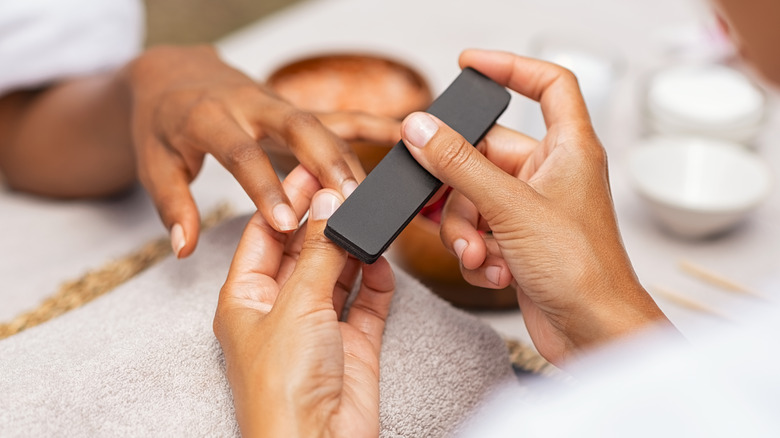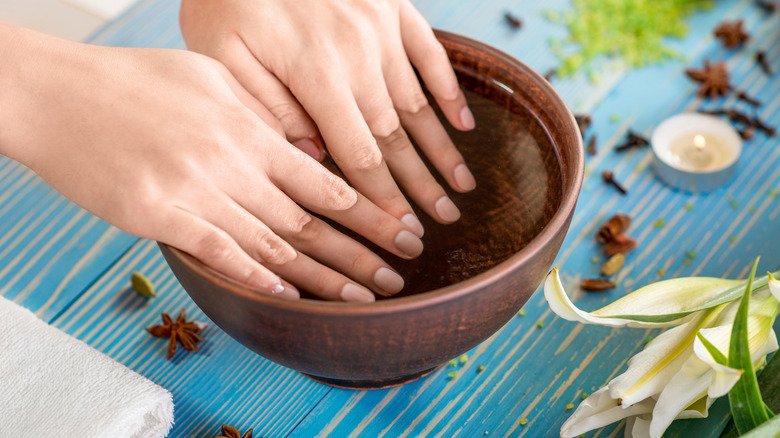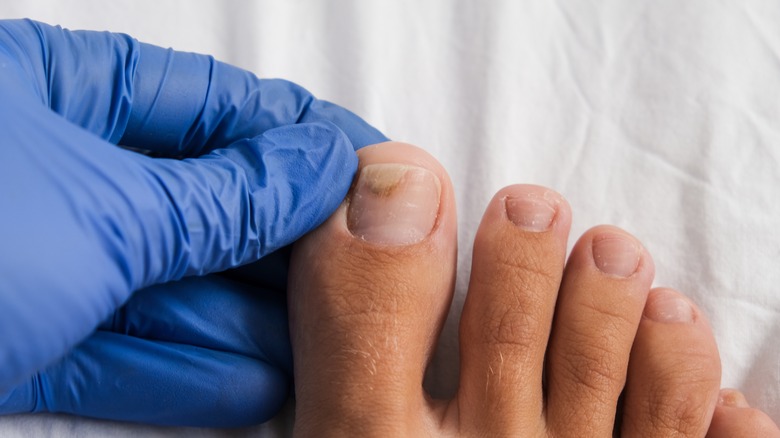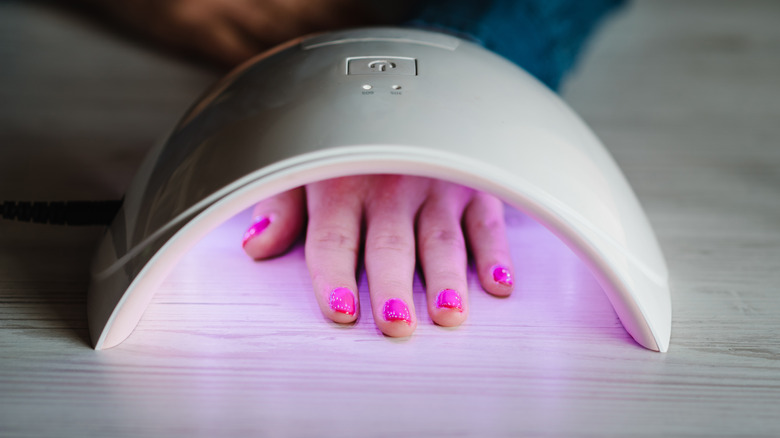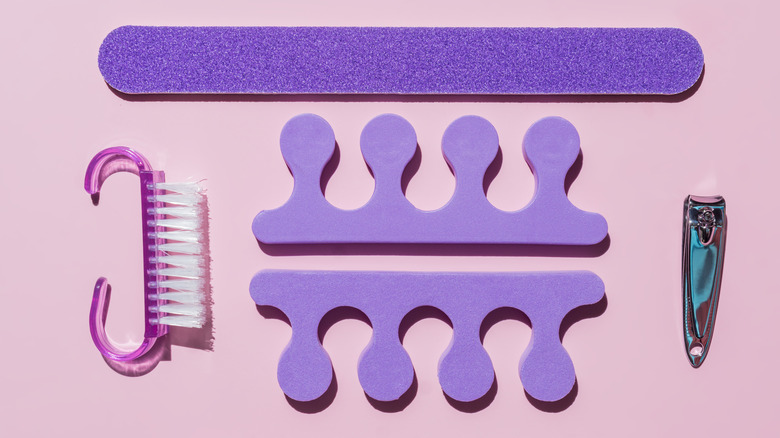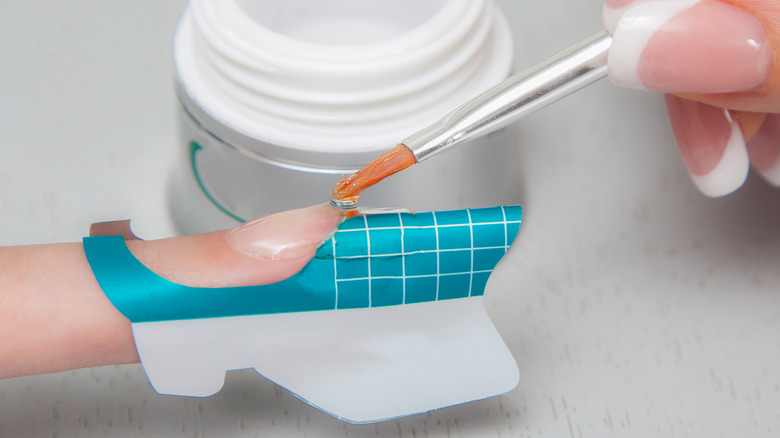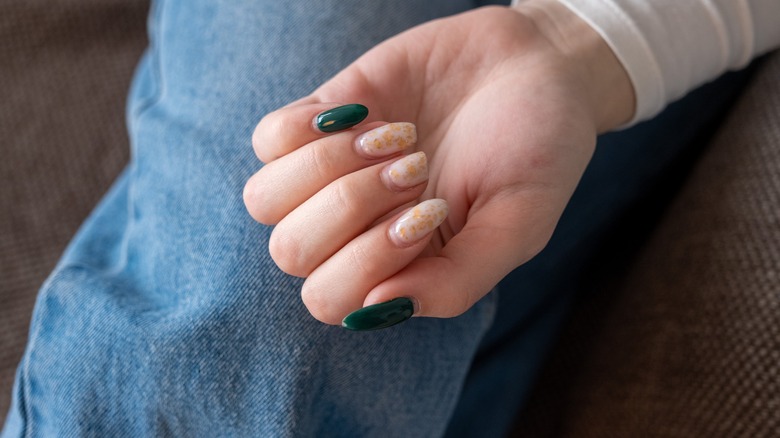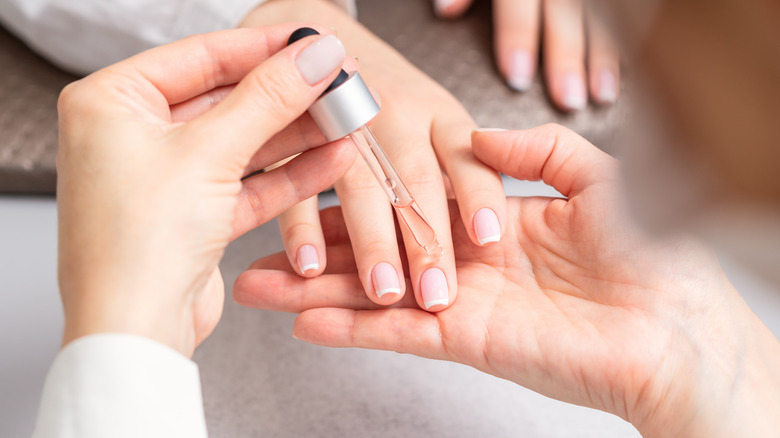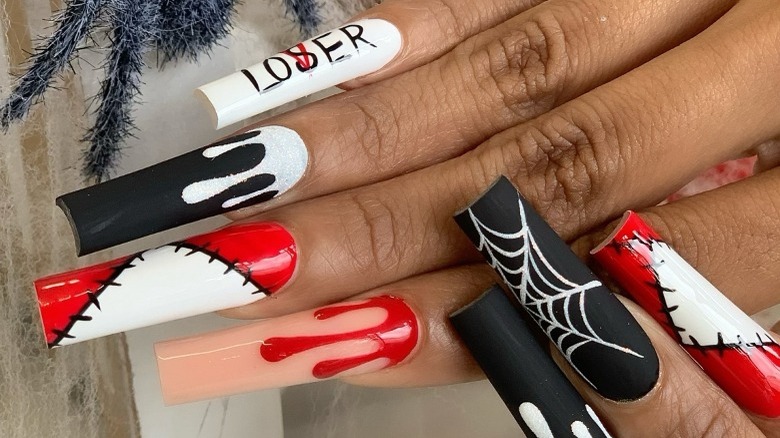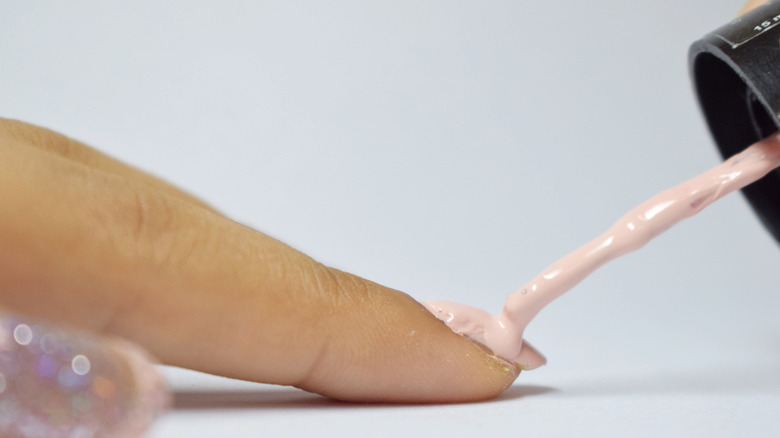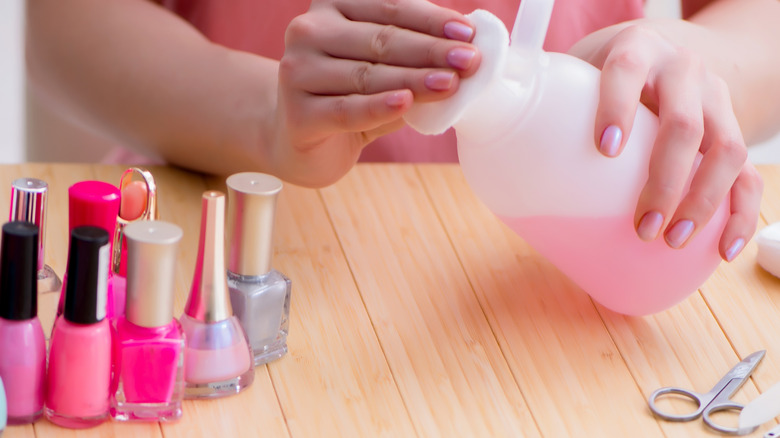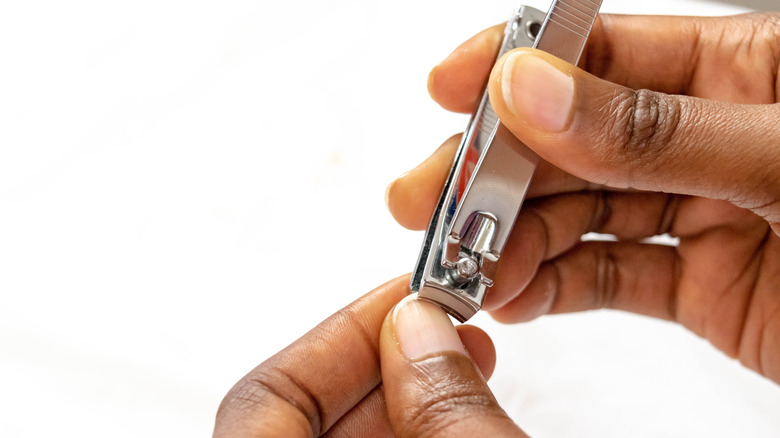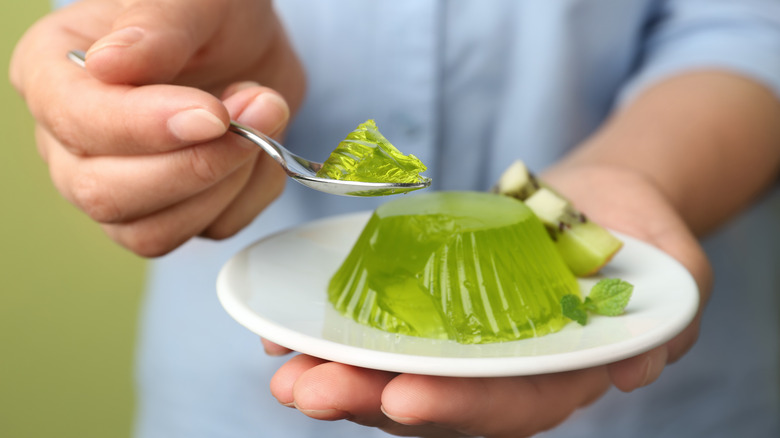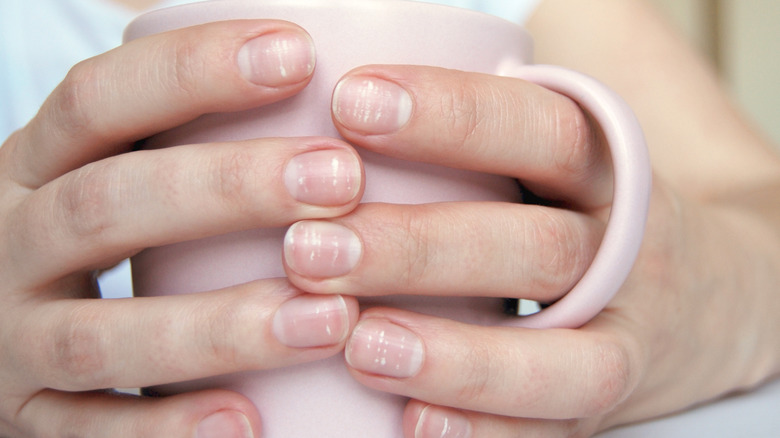Myths You Have To Stop Believing About Manicures
We may receive a commission on purchases made from links.
It isn't until you start caring about the strength, length, and health of your natural nails that you'll find the decades-old cesspool of misleading information spreading around the nail community. From eating gelatin for stronger natural nails to thinning nail polish with acetone, we've collected several of the most popular (and some of the most harmful) manicure myths that are wasting your time and possibly ruining your nails.
Luckily for us, many of the most prevalent fibs being pushed on social media are easy to debunk with some minimal internet sleuthing. Entire careers stem from the creation of beautiful and healthy fingernails, so there is quite a bit of research out there and lots of professional opinions about the good and the ugly of nail care.
Ultimately, you can keep your manicure looking great using some basic care. When you start buying into trendy nail hacks, the process becomes much more confusing. Keep it simple and remember that hydration and the proper techniques are key. The following manicure myths are only harmful to those who aren't doing their research. The easiest way to protect your nails from the buckets of misinformation out there is to read up on what nail professionals and medical doctors are saying.
Myth: You should soak your nails in water before a manicure
Soaking your nails in water used to be common practice before getting a manicure. The warm water would soften the cuticle allowing for easy removal during the nail preparation stage. Although this is still true, now we know that the practice of soaking can change the shape of your natural nail plate as it absorbs the water and expands. This is not good if your goal is a durable manicure because as your fingernails warp and change, any polish applied to the surface will move too, causing chipping and peeling.
Cuticles can still be removed during nail prep. It is much safer, however, to use the proper tools such as a cuticle pusher and a cuticle remover. If you are still struggling to remove them fully, some nail professionals recommend Sally Hansen's Instant Cuticle Remover Oil. When used correctly, this type of cuticle removal is among the safest methods to replace soaking your nails in water. Simply apply it and gently scrape away the dead skin from your nail bed.
Myth: Fungus is killed by nail primer
This myth is more like a half-truth. While there are medicated nail primers that can kill fungus, most nail primers, intended for preparing your nails for gel polish, do not have the ingredients needed to kill the fungus entirely or quickly. Medicated nail primer or polish contains amorolfine or ciclopirox, both of which kill nail fungus over time through topical use. You can also paint over this type of nail primer with regular nail polish too if you want to cover the nail.
Signs of nail fungus include a thick, discolored, and misshapen nail plate that may be lifting off of your skin depending on the seriousness of the infection. The skin beneath and around the nail may also be painful, swollen, or bleeding. Nail fungus primarily affects the toenails as they are more often subjected to warm and moist environments compared to our fingernails.
Most fungal infections that are still in the early stages can be treated at home with a medicated nail primer, however, severe cases may need a doctor's attention.
Myth: UV and LED curing lamps cause irreversible sun damage
All nail lamps emit UVA rays that can cause sun damage leading to skin aging or melanoma. But according to the Skin Cancer Foundation, even under the most powerful lamps, the risk of UV damage is only moderate.
There are two types of commonly used nail curing lamps: UV and LED. Both lamps radiate UVA rays, however, the newer LED lamps are considered to be safer than UV lamps. They take about half as much time to cure gel nail polish and they beam out fainter rays.
As long as you aren't putting your hands under these nail lamps every day, your risk of irreversible sun damage is very low. Most people reapply their gel manicures once every two to three weeks. This minimal amount of UVA exposure doesn't raise the risk of skin cancer any more than a walk outside on a sunny day. Still, it is always a smart idea to protect your skin from these rays when you can. Applying sunscreen to your fingers and wearing protective fingerless gloves, like the MelodySusie UV Gloves, can be beneficial to your skin's health.
Myth: You must bring your own tools to a nail salon to avoid getting an infection
Truth be told, there is no harm in bringing your own tools to the nail salon to avoid using anything that has been used on other clients. Most salons have no problem with this as long as your tools are clean and relatively of good quality. But, you should keep in mind that all nail salons have laws and standards they must follow to keep their customers safe from infection. All of their metal nail tools are heat-sterilized, sanitized with UV light, or disinfected with chemical solutions. It's in your best interest to research a nail salon before booking an appointment to see if they are performing safe services. At a proper salon, you shouldn't have to fear infection.
If you still feel wary, the only salon tools that you would really need for yourself are pumice stones, emery boards, nail buffers, and foam toe separators, as they cannot be disinfected the way metal tools are. However, in most trusted salons, these tools are disposed of each time they are used, so bringing your own is unnecessary.
Myth: You have to use nail tips with gel extensions
Gel extensions are a relatively new way of getting longer and stronger false nails. Like acrylics, one of the first steps to build the gel nail is to apply a full cover nail or a nail tip to your natural nails. After gluing on a tip, you apply hard gel or builder gel to shape it, and finally, you paint your color or design on top. There is now a new option to achieve the same look without the use of nail tips called nail overlays. Once the gel is applied to the natural nail bed, the nail is shaped and buffed. The overlay technique creates stronger and more uniform nails without adding much length.
If you still want to create long nail extensions without nail tips, you can with a paper nail form, a nail brush, and hard gel. On the YouTube channel YoungNailsInc, a professional nail technician suggests "floating" the gel gently across the nail and the form to get a uniform look. She also shows off a tool called a Precision Gel Applicator, which keeps manicurists from "bunny hopping" on the nail creating air bubbles in the gel.
Myth: Acrylic nails are stronger than hard gel extensions
Acrylic nails have long been the top choice nail extension method for many people who get regular manicures. Acrylic powder for nails is strong, it can add length, and it can be designed in many artistic ways. But as gel products and hybrids find more popularity in the mainstream nail community, more nail techs are experimenting with gel extensions. However, some people are still shying away from the new product as it is believed to be less durable than acrylic. However, this belief is not necessarily true.
In fact, some nail artists are saying that hard gel is actually more durable than acrylic. Because the gel is more flexible and forgiving, it can handle more stress from being stubbed, pulled back, or flexed, making it way more difficult to crack. Additionally, due to its flexible nature, gel rarely takes your natural nail with it if it were to break, which means less brittleness, and fewer white trauma spots and uneven nail plates on your natural nails.
Myth: All nail enhancements ruin your nails
Nail enhancements will absolutely harm your nail bed if you or your manicurist is using the wrong technique. All kinds of nail enhancements including gel polish, gel overlay, acrylics, dip nails, gel extensions, and even press-ons, can be damaging to your nails if you aren't careful. Yet, with proper nail prep, application, aftercare, and removal, your nails could become stronger as the nail enhancement protects them from environmental threats, nail-biting, and injury.
The key to having healthy nails is treating them with diligent care. Keeping your hands and cuticles hydrated, avoiding using your nails as tools, and proper removal of nail enhancements will allow you to have the best of both worlds: consistently decorated nail extensions and healthy natural nail beds.
Although nail enhancement removal is never "good" for your nails, chemically removing them with acetone and gently scraping off the excess is the most forgiving way you can go about it. By protecting your skin with vaseline, washing your hands thoroughly, and applying cuticle oil and hand cream afterward, you can keep your nails and skin hydrated, preventing brittleness and damage.
Myth: Your nail strength is determined by your nail shape
Many people seem to think that short to medium square and almond-shaped nails are less prone to cracking and breakage due to their shape. Yet, it's been said by professional nail technicians over and over again that your nail strength is actually determined by your apex, not your nail shape. The apex of your nail is the thickest point of your extensions when positioned horizontally. Depending on your nails' length and shape, the apex may be closer or further away from your cuticle to provide the most support from base to tip.
The apex is also positioned in a specific part of the nail called the stress area. The stress area is where nail enhancements crack and break most often as it is where all the pressure collects when you stub or flex your nail. The better the placement of your apex, the stronger your nail extensions will be no matter if they are made of acrylic, gel, or a hybrid product.
Myth: You shouldn't shake your nail polish
For decades we have been shaking our nail polish bottles and listening to that bewitching sound of the metal balls clinking around in the glass container. The purpose of shaking the nail polish is to mix up the formula so your nail polish is smooth and everything is blended. There isn't much science behind this practice and countless nail polish brands use different ingredients in their formulas making it difficult to decipher what method is best before painting. Yet, as many professional nail technicians will tell you, shaking is their preferred method to mix their polishes.
A rumor has gone around the nail community that shaking your nail polish bottles before use creates bubbles that will ruin your manicure. Because of this, some people have started to gently roll their bottles between their hands or not mix up their polish at all. Not mixing is counterintuitive to the problem though, since some parts of the formula have settled and separated, it is much harder to get an even coat on the nail. If you're still struggling with gloopy nail polish you may need to buy higher-quality products or an electric nail polish mixer like the ProShaker.
Myth: Nail polish remover can help thin your old polish
Old nail polish has a habit of becoming gooey and clumpy after sitting on your shelf for a while without being used. This is because, the older a nail polish becomes, more and more of the solvent that keeps it liquid will evaporate. The easiest way to fix this is to mix in more solvent to keep it flowing for easy application.
For years, though, websites have been leading us astray, telling us that it is just fine to add nail polish remover to our gloopy nail polish. Technically, the remover will make your nail polish thinner, but at what cost? Most nail polish removers contain acetone which is a type of solvent that can dissolve paint. When acetone is introduced to nail polish, it destroys the original formula causing it to discolor, become less shiny, and sometimes make it totally unusable.
Instead, we recommend that you use nail polish thinner. One popular version of this is the Ella+Mila Nail Polish Thinner. After mixing just a few drops of this into your clumpy nail polish, it makes your gel, creme, top coat, or glitter polish good as new.
Myth: You must give your nails time to breathe between sets
How many times have you heard someone say that your nails need to "breathe" after a few rounds of gel manis or acrylic nail applications? Believe it or not, this is false. Fingernails get their oxygen from your blood, not from the air. They can be continuously covered and still breathe just fine. If you find that your nails are becoming brittle or damaged after a few different nail sets, this is probably due to trauma during removal or a lack of hydration.
As noted before, it's imperative that you keep your nails healthy through proper removal and the use of cuticle oil and hand cream. Cuticle oil is an essential product that must be used daily to keep your nails in good health. Just like face moisturizer and body lotion, skipping a few days will leave your skin feeling dry and could lead to flaking. For your nails, dehydration causes brittleness, chipping, and damage.
Myth: Eating gelatin regularly will strengthen your nails
There are seemingly hundreds of quick fixes to get healthier nails. While some of them are strange and easy to avoid so long as you have common sense, others may actually seem truthful and worth trying. One of these nail-boosting claims, eating gelatin for stronger nails, is simply a myth. However, it gained traction because the idea does have some accuracy to it.
Your nails, which are made up of a structural protein, become more brittle with repeated damage and dehydration. The collagen in gelatin is a structural protein that our skin and other parts of our bodies use to stay healthy. So, wouldn't it make sense that eating gelatin would restore some of this protein to your damaged nails? Unfortunately, no. Though collagen is a necessary structural protein in humans, our nails are composed of keratin, a similar but unrelated protein. Because of this disconnect, no matter how much gelatin you eat, your nails will not end up any stronger than they were before.
Myth: White dots on your nails is a sign of a mineral deficiency
A person who is deficient in calcium, iron, or zinc, may show signs of lacking these vitamins through white dots and lines on their nails. But, much like a rectangle is not a square, a person with the same white dots and lines may not have a mineral deficiency at all. The markings have numerous causes and mineral deficiency is among the least likely of the bunch. If you regularly work with your hands, you may notice a white dot or line across one or more of your fingernails. Usually, this occurs when you forcefully hit your nail. Something as small as biting your nails or getting a sub-par manicure can also lead to white spots.
You should be aware, however, that certain medical conditions, fungal infections, and allergic reactions can also be the cause of these marks. White spots and stripes caused by injury will eventually grow out, if yours doesn't it could indicate a larger problem.
